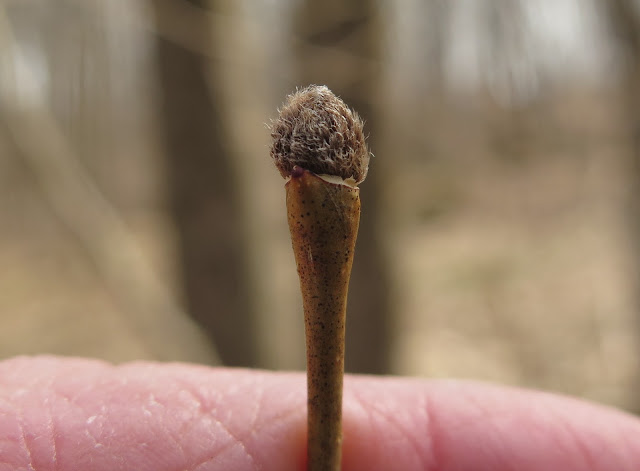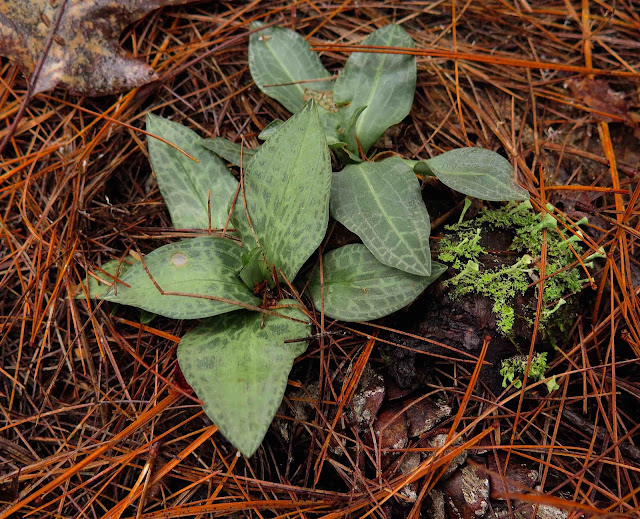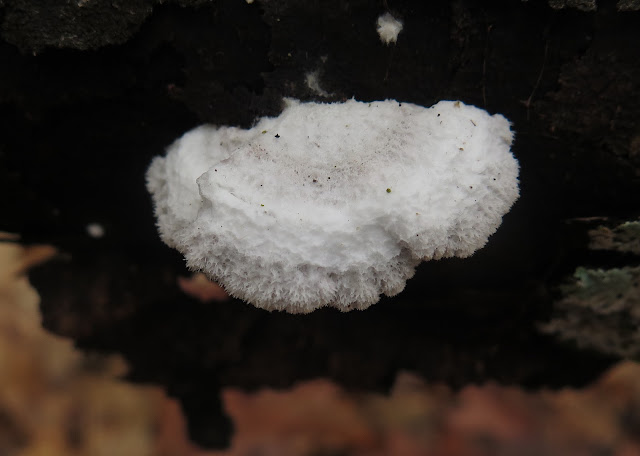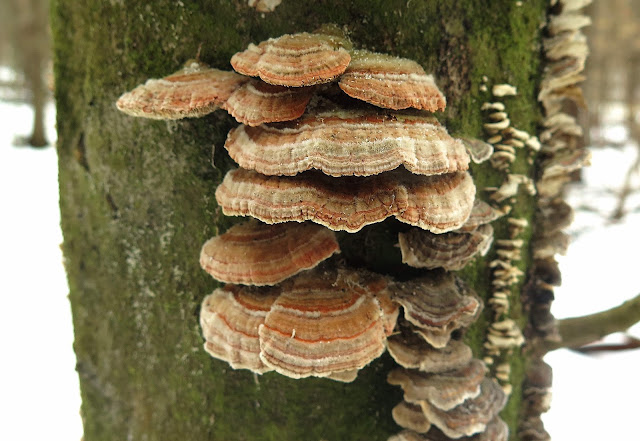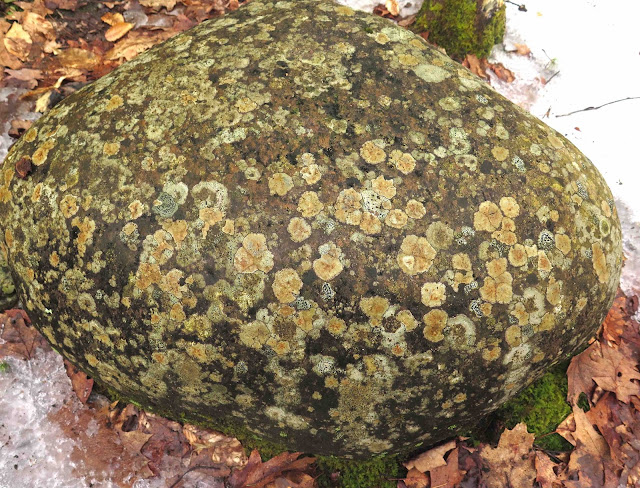Here it was, March 20, the first official day of Spring, and right on schedule I found in bloom the first wildflower of Spring that actually looks like a flower: some sunny little Coltsfoots pushing up from the mud along the Spring Run Trail in downtown Saratoga Springs. While it's true that Skunk Cabbage bloomed a few days earlier, many casual observers of those bulbous spathes might not recognize them as being flowers. But no one would mistake the quintessential "flower-ness" of Coltsfoot -- which closely resembles the first flowers our children might have drawn with a yellow crayon. These two -- the Skunk Cabbage and the Coltsfoot -- represent the first trickle of what will very soon be a great wildflower flood: Hepatica, Bloodroot, Blue Cohosh, Foamflower, Columbine, violets of many species, etc., etc., all coming on so fast that wildflower nuts like me will have to scurry to keep up with them.
But before I get swept along on that floral flood, I want to pause to celebrate some of winter's woodland wonders, a few of the many beautiful and otherwise fascinating finds that tempted me out into nature throughout the winter. What follows here is just a sampling of the incredible variety of wonders my friend Sue Pierce and I found in just this past week, and at only two still-rather-wintry locations: the Spring Run Trail and the Bog Meadow Brook Nature Trail, both trails in Saratoga Springs.
Winter Fungi
I am always astounded by how many fungi persist through the winter, many of them retaining their beautiful shapes and colors no matter how many punishments the worst winter weather assails them with. Among the most abundant of these is one called Crimped Gill Fungus (Plicaturopsis crispa). Often quite small as individuals but almost always growing in massed rows along rotting limbs, this rather ruffly-looking fan-shaped fungus retains its warm brown zonal stripes all winter.
But as pretty as the tops of these small mushrooms might be, the truly ruffled undersides are just as lovely, if maybe even more so, displaying the crinkly gills that suggested this species' vernacular name.
Another common persistent fungus is the Split-gill Fungus (Schizophyllum commune), another stalkless wood-dwelling fungus that also tends to stay quite small. The one pictured here is typical of how this fungus appears in late winter: still as white as it was when fresh last fall, it has over the winter acquired what resembles a furry coat.
To observe how this fungus acquired its names (both scientific and vernacular), simply flip it over and there you will find its obviously split gills. This is truly one of our most fascinating fungi, possessing many amazing attributes, which I once wrote about in
this blog post.
Despite its often tiny size, the sac fungus called Lemon Drops (Bisporella citrina) is hard to miss, not only because of its brilliant color, but also because it tends to fruit in masses, glowing colorfully against the dark of de-barked rotting wood.
Here's a closer look at those Lemon Drops, revealing the shapes of the tiny discs that suggested another of its vernacular names: Fairy Cups.
While those Lemon Drops may seem to glow because of their bright color, this much-more-muted wood-dwelling fungus earned its descriptive vernacular name, Luminous Panellus, by actually glowing in the dark. I have never witnessed this trait myself, but every one of my mushroom guidebooks mentions it. This mushroom's scientific name, Panellus stipticus, was possibly suggested by its reputed ability to staunch bloodflow from wounds.
I have found Luminous Panellus in the fall, before its plain-brown caps had acquired the frosty bloom it displays now, so I might not have recognized it if I hadn't turned it over to observe how its gills radiate from an off-center, very short curving stalk, a distinctive trait. (Also, my friend Sue used her I-Naturalist app to discern its species.)
Here was a rather plain-looking shelf fungus, possibly having lost some color over the winter, but still looking rather attractive, sharing a fallen tree limb with colorful lichens and mosses. From the top, it could have been one of several similar-looking fungi.
But a glance at this mushroom's fertile surface revealed a maze-like pattern to its gills that indicated it was one of the maze-gill fungi, probably the Thin-walled Maze Polypore (Dadaeleopsis confragosa).
I found other mushrooms, similarly plain and pale on top but differently gilled on their fertile surface. Could these mushrooms also be Dadaeleopsis confragosa, despite their undersides' more vivid color and a more squiggly shape to their maze-like gills? My mushroom guides do suggest that this species can vary quite a bit. Whatever their actual species, I was enchanted by their remarkably interesting appearance.
We seem to have quite a few colorfully striped shelf fungi, and at first glance I was sure these must be the one called Turkey Tail, with its alternating zonal stripes of tan and orange. But I was wrong!
When I flipped one over, I could see that the undersides of these mushrooms were definitely gilled, not like the smooth white surface consisting of tiny pores that is diagnostic for the real Turkey Tail (Trametes versicolor). I am going to guess that this mushroom is instead Lenzites betulina, which is known to closely resemble the Turkey Tail, except for possessing a gilled fertile surface. In fact, the vernacular name for this fungus is Gilled Polypore (an oxymoronic name if there ever was one!)
I wonder if this next mushroom could also be Lenzites betulina, perhaps a younger specimen with gills not yet dried out. The bright-yellow color suggested to me that it must be another species, but when I looked at Google Images of Lenzites betulina, I found that that species can display quite different colors, including this gaudy gold.
Here are the gills of that yellow fungus. They do rather resemble the gills of Lenzites betulina. I would certainly welcome alternate suggestions from readers more knowledgeable than I am.
The color alone of this rather flabby mushroom suggested to me that it might be the Orange Mock Oyster (Phyllotopsis nidulans), a guess that its kidney shape, inrolled margins, and lack of stalks reinforced. A check through my mushroom guides when I got home confirmed that ID. Despite the vernacular name, this is not an edible mushroom. It stinks, I read, and the taste is very bitter.
Could this be a newly developing Orange Jelly Fungus (Dacrymyces palmatus)? Or is it a persistent remnant of one that has made it through the winter unscathed? It does look a bit desiccated, so I'm guessing it might be an old one. Is that white fluffy stuff its mycelium? Is it ready to start producing new growth? Part of the fun of these woodland finds is trying to guess what I'm seeing. And also realizing I don't have to know everything.
For example, I have no idea what these tiny orange jelly dots are. Will they grow into something more recognizable in time, like maybe some Fan-shaped Orange Jelly? Are they newly emerged, or have they been here all winter? For the moment, I was simply content to be delighted by how lovely they looked nestled in among the pretty green moss.
More teeny-tiny jelly dots, these being tan, not orange. And very, very tiny! I have been finding them on rotting woods for years, but I never found any photos that resemble them at all in my mushroom guides. Finally, this week I posted this photo on a Facebook mushroom site and got an answer, one that a Google Images search verified: they're called Helicogloea compressa, and they have no vernacular name that I could discover. Nor could I find any more information about them anywhere. How odd! I find them often, so you'd think mycologists have found them too and have written them up somewhere. They probably have, but not in publications found on Google!
It's hard to imagine a fungus more distinctive than Red Tree Brain Fungus (Peniophora rufa), a crust fungus whose scrunched-up wads of red waxy stuff can be found dotting the bark of poplars or willows.
Here's yet another quite distinctive fungus that I've only recently been seeing, and there's a good reason for that. As its vernacular name, Asian Beauty, suggests, this is not one of our native fungi but rather one that has only recently been introduced to North America from Asia. Its first reported sighting in the U.S. was as recent as 2019, in Massachusetts. And I have just this winter found several examples of it here in Saratoga County, pale-ivory, needle-thin, tiny sharp teeth that stretch, ribbon-like, along cracks in fallen logs. Radulon coplandii is its scientific name.
I must confess that this patch of bracket fungi had me stumped. First, was that sprawling mess of crust-like growth the infant stage of what would become the fan-shaped, striped-edge fruiting bodies projecting from this rotting log? And while these fungi vaguely reminded me of the Violet-toothed Polypore, I could not detect a trace of purple about the stripes that edged the pale-ivory semi-circles.
But when I examined the underside of one of the specimens, the rough-textured surface looked very much like that of an aging Violet-toothed Polypore (
Trichaptum biforme), its normal purple color faded to the rusty brown described in my mushroom guides. I also recalled having once read on the
"Mushroom Expert.Com" site that "Sadly, the purple shades of
Trichaptum biforme soon fade, leaving only the slightest hints of their former glory." So unless I hear otherwise, I'm sticking with Violet-toothed Polypore. In its winter colors. (But I'm still not sure about that sprawling mess.)

This last winter fungus we found this past week has no caps or gills or pores or any of the other observable features we might use to determine a mushroom's identity. But in the case of the Blue-Stain Fungus (Chlorociboria aeruginascens), we don't need any of those. No other fungus stains wood this particular deep-turquoise color with its mycelium. Although this fungus does occasionally produce tiny ear-shaped fruiting bodies of a most intense blue-green color, patches of this colorfully stained wood can be seen at any time of the year.
Winter Liverworts, Lichens, Mosses, and More
The fungi listed above are simply a sample of the many other remarkable fungi we found at those two sites over the course of our two outings. The same could be said for the various organisms listed below. Sue and I had entered these nature preserves with a specific goal in mind (to find some blooming Skunk Cabbage). Yes, we promptly found what we came for, but two hours later we were still poking about among the wooded wetlands' many treasures, calling out to each other to come see our special finds, and laughing about how "it didn't take much to amuse us." Except, of course, that the things we found were actually true treasures. Treasures that are there to delight us in every season, including the winter.
One of the wonderful things about liverworts, lichens and mosses is that they can be observed all year, even if we have to brush the snow aside to see them. In the case of this gorgeous liverwort, though, it was mounded well above the melting snow, so we could see every furry branchlet of this bright-green, fluffy-textured Handsome Woollywort (Trichocolea tomentella). Not many liverworts have vernacular names, but this one has one of the best ones imaginable.
Here's another beautiful liverwort, the glossy-leaved Bazzania trilobata, sometimes called Millipede Weed for the way its branches resemble such segmented arthropods. Within this compact circular mound, the Bazzania is interspersed with a spiky-leaved moss I don't know the name of.
I don't know the name of the crustose lichens beautifully decorating this large boulder. Or even how many species of lichen there might be. I just gazed in awe at what a beautiful mix of colors and textures they added to the rock.
Of all the mosses we found these two days, I was particularly delighted by the bright lime-green color and fur-like texture of this Dicranum scoparium, sometimes called Windswept Broom Moss for the way its leaves all appear to be swept to one side.
I realize I've neglected to include our evergreen ferns in this post about "Winter's woodland wonders," but at least I've included this interesting "fern ally" called Dwarf Horsetail (Equisetum scirpoides). True to its vernacular name, it is a very small Horsetail. I can find four other, much larger species of Horsetail at Bog Meadow Brook Nature Trail (which is where this one abounds), but this is the only Horsetail there that stays green and keeps its twisty-squiggly stalks all winter long. In the summer, it will bear spores in tiny cone-like structures at the ends of some of its stalks.
Yes, there's a patch of a pretty green moss, called Delicate Fern Moss (Thuidium delicatulum) in this photo, but that's not why I stooped to take the photo. I was drawn instead to this Foamflower leaf (Tiarella cordifolia) that had turned such a lovely rose color. Many Foamflower leaves do stay green all winter, but some of them turn quite beautiful shades of red.
Again, there's that Delicate Fern Moss in this photo, but my focus here was on this amazing spider web spangled with water droplets. I doubt very much that the spider that spun this web was active all winter. So its new-spun web must be instead another sign of Spring, one of the first of Spring's Woodland Wonders that await in the weeks to come.




